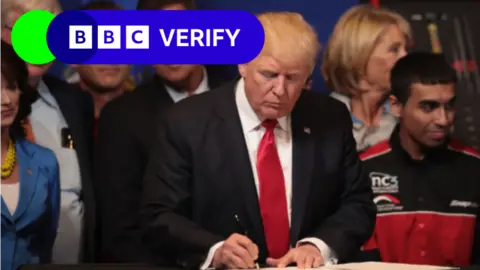The recent discourse surrounding H-1B visas in the United States has ignited a notable conflict among supporters of former President Donald Trump. This visa program, established to allow U.S.-based companies the ability to import skilled labor from foreign nations, particularly stirs controversy among immigration conservatives who assert that it undermines American job opportunities. Conversely, supporters maintain that the program is essential for attracting top-tier talent necessary for maintaining the United States’ competitive edge on a global scale.
An intriguing development emerged in light of this debate when Trump publicly endorsed the H-1B visa program, a stance that significantly conflicts with his previously vocal disapproval of it. Notable figures, including tech entrepreneur Elon Musk, have echoed this sentiment, arguing that the scheme is instrumental in attracting what Musk terms the “top ~0.1% of engineering talent.” Amid ongoing political aspirations, including Trump’s potential return to the presidency, this visa program may play a pivotal role in shaping future immigration policy.
The H-1B visa program was first introduced in 1990, primarily aimed at enabling qualified professionals to work in sectors that experience a shortage of domestic labor. Typically, H-1B visas are issued for periods of three years, with the possibility of extension up to a total of six years. Since 2004, the U.S. government has imposed an annual cap of 85,000 new H-1B visas, out of which 20,000 are specifically reserved for foreign students who have obtained master’s degrees or higher from U.S. institutions. However, it should be noted that certain organizations—including educational institutions and research nonprofits—are exempt from this cap, resulting in a greater number of visas being allocated annually than the statutory limit suggests.
To qualify for an H-1B visa, applicants must secure a job offer from a U.S.-based employer, who acts as their sponsor. Data reveals that during the 2023 fiscal year, a total of approximately 386,000 H-1B applications were approved, which included nearly 119,000 new H-1B visas and about 267,000 extensions for existing visa holders. This reported number signifies a decline compared to the previous fiscal year, which saw over 474,000 approvals. The heightened level of scrutiny and heightened rejection rates seen during Trump’s tenure also remain a critical part of the discussion, particularly as these rates surged to unprecedented levels at one point.
Another essential aspect to consider is the distribution of H-1B visa holders across various sectors. The predominant fields of employment for approved applicants are heavily skewed towards science, technology, engineering, and mathematics (STEM). In fact, around 65% of the economies that were granted visas in 2023 belong to computer-related professions, with employees from major companies like Amazon, Google, and Meta being significant beneficiaries of this program.
Compensation for H-1B visa holders also deserves attention; the median annual salary garnered by these employees in the 2023 fiscal year was approximately $118,000. Comparatively, workers in similar domains, including their American counterparts, tend to earn slightly less. Opponents of the H-1B visa structure often suggest that these foreign employees undermine the wages of American workers. However, experts in immigration law counter this narrative by demonstrating that most H-1B holders earn more than the prevailing wage for their roles.
Importantly, a significant proportion of H-1B workers hails from India, comprising around 72% of visa approvals, with Chinese nationals making up the next largest group at 12%. A demographic breakdown indicates that approximately 70% of visa holders are men, with an average age around 33.
As discussions unfold regarding potential reforms in the H-1B visa program, stakeholders like Eric Ruark from NumbersUSA emphasize the critical nature of resolving this immigration debate. With the possibility of Trump’s reinstatement as president looming, there is growing speculation regarding whether his administration will prioritize American labor interests or revert to an immigration policy designed to facilitate employer needs, thereby impacting future H-1B visa policies. This ongoing dialogue captivates not only Trump supporters but also policy-makers and business leaders invested in the roles that skilled immigrants play in the U.S. economy.



